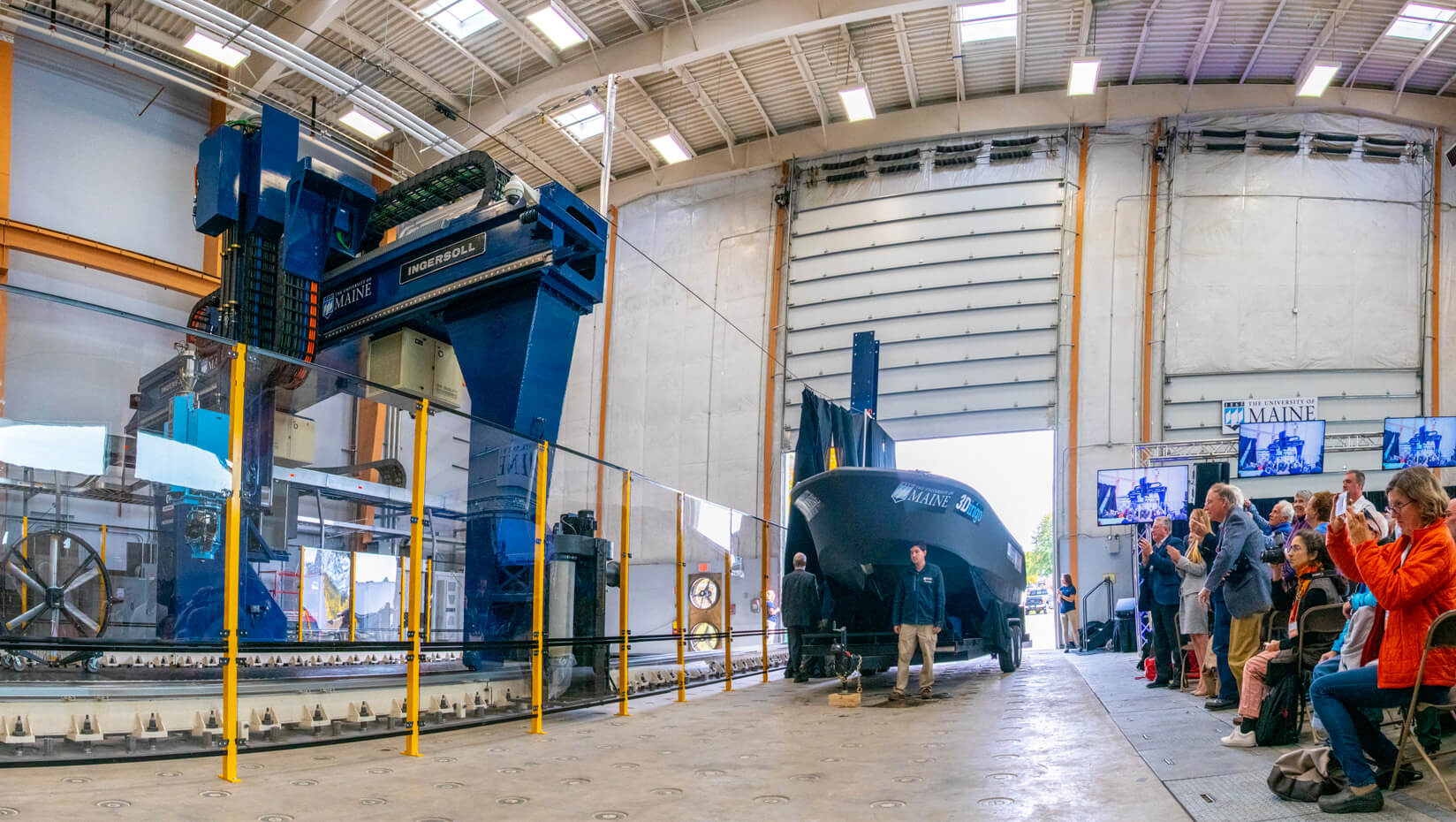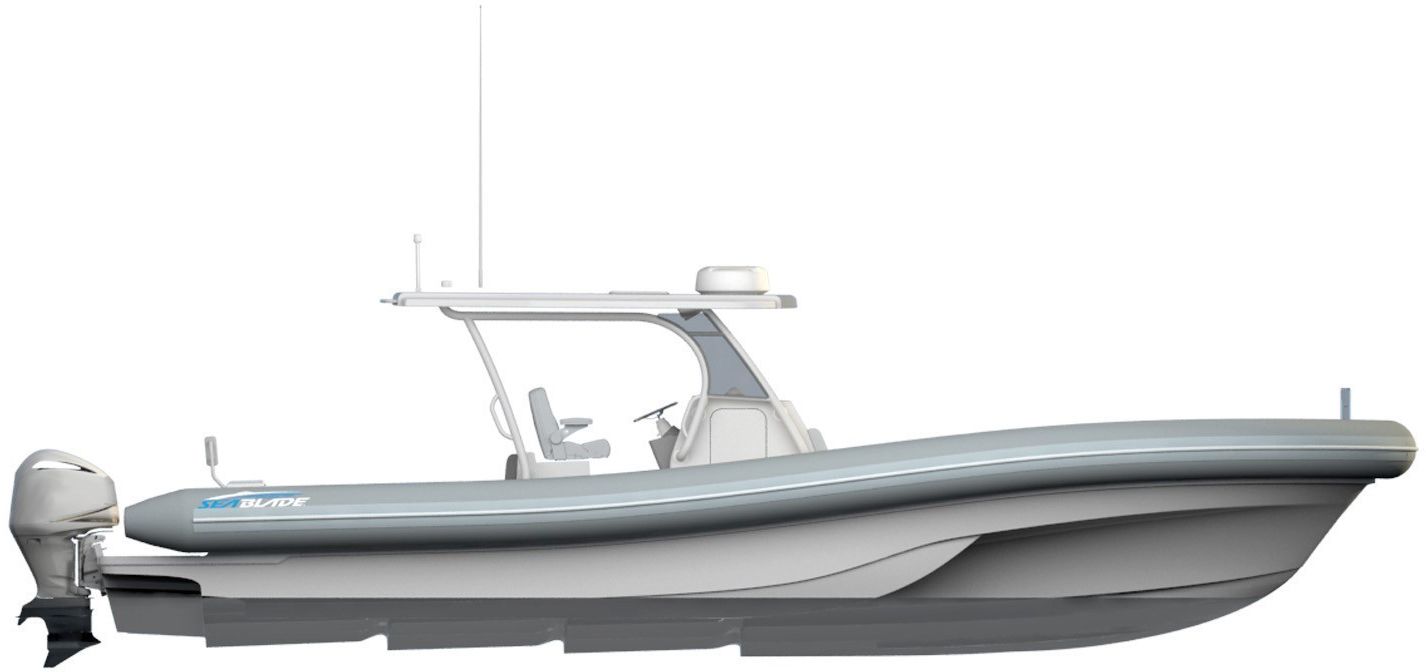The University of Maine’s (UMaine) Advanced Structures and Composites Center (ASCC) has achieved world records in 3D printing over the last year, and has been an example of how successful collaboration, between universities and national military (US Military) and research organizations (Oak Ridge National Laboratory, ORNL), can advance additive manufacturing (AM), especially in traditional, capital intensive industries such as maritime.

World’s largest polymer 3D printer, and 3Dirigo, the world’s largest 3D printed boat. Image Courtesy of UMaine ASCC.
In its collaborations, the university has partnered with Navatek, a maritime design company that provides R&D services to the US Department of Defense (DoD), NASA and other government agencies. The record-breaking 3Dirigo—the world’s largest 3D printed boat and solid object—had its hull form designed by Navatek, and just this month, the partnership has won a $5 million contract from the DoD’s Office of Naval Research.
The contract is to fund research into materials and novel manufacturing tools, such as the world’s largest polymer printer developed at University of Maine, that would transform the design and construction of Navy and Marine Corps vessels. In February this year, the University of Maine’s ASCC collaborated with the US Army to fabricate a full-scale, 3.6 meter tall, vehicle shelter in under two days.
Earlier in 2019, Navatek had also won a $8 million contract from the US Navy to improve the design and manufacturing of small, high-speed surface vessels for operation in rough seas.
“Our collaboration with Navatek is what attracted them to opening offices in Maine,” Habib Dagher, the ASCC’s executive director, said. “We look forward to continuing our partnership with Navatek and the ONR [Office of Naval Research], creating transformative knowledge in advanced manufacturing for the Navy and transferring that knowledge into high-paying, Maine-based jobs… This project is a result of UMaine’s work last year where we commissioned the largest polymer 3D printer in the world at UMaine-ASCC and 3D printed a 25-foot-long, 5,000-pound patrol vessel.”
Navatek’s CEO, Martin Kao stated, “Navatek is proud to work with the University of Maine in support of the Navy and Marine Corps’s goal of fielding unmanned surface vessels or USVs. Along with our office in Portland, Navatek recently opened a second office in Bangor, which is collocated with the University of Maine to increase collaboration. We are expanding our presence in the state to 80 engineers and scientists in our Bangor and Portland offices over the course of these programs, with room to grow to over 120 in our new facilities, expected in 2021.”
In October last year, researchers at UMaine won three Guinness World Records—for the largest polymer 3D printer, the largest solid 3D printed object, and for the largest 3D printed boat—the 3Dirigo, a 7.6 meter long, 2.2 ton thermoplastic boat was printed in just over 70 hours. The boat is a remarkable proof of concept indicating the potential AM has in transforming maritime manufacturing. The world’s largest printer, that made the boat, can print objects as large as 30 m long, 3 m high, and upto 6.7 m wide, outputting at speeds of 227 kilograms per hour.
What’s particularly interesting is the approach with materials that is being taken for large-scale additive manufacturing in boat building. While typical molds are expensive and time-consuming to manufacture, this 3D printed is focused on producing large-scale structures using thermoplastics combined with bio-based (cellulose nanofibers (CNF), or wood cellulose) materials. These materials would provide comparable strength to metals such as aluminum, while making manufacturing recyclable and more economical than before. In May last year, ORNL and UMaine had been awarded $20 million from the Department of Energy’s Advanced Manufacturing Office for collaborative research into bio-based materials and applications.
Regarding the award, US Senator Collins stated,
“While Oak Ridge is a global leader in additive manufacturing, the University of Maine is an expert in bio-based composites. By working together, they will strengthen environmentally responsible advanced manufacturing in America as well as helping the forest industry in the state of Maine.”
Regarding the research being done at UMaine’s ASCC, Habib Dagher stated,
“Our goal is to print with 50% wood products at 500 pounds (227 kilograms) per hour…. The material is nanocellulose, basically a tree ground up to its nano structure. These materials have properties similar to metals. We are taking those and putting them in bioplastics so we can make very strong plastics that we can make almost anything with.”
This would reduce the cost in marine tooling by more than 50%, reduce lead time to a matter of days, improve sustainability in the manufacturing process, and bring efficiency and flexibility into large-scale additive manufacturing across industries.
Subscribe to Our Email Newsletter
Stay up-to-date on all the latest news from the 3D printing industry and receive information and offers from third party vendors.
Print Services
Upload your 3D Models and get them printed quickly and efficiently.
You May Also Like
Caracol Acquires Weber’s 3D Printing Assets
Italian large-format 3D printing specialist Caracol has acquired the additive manufacturing assets of Germany’s Hans Weber Maschinenfabrik GmbH, a long-standing leader in extrusion technology. The deal includes Weber’s intellectual property...
3D Printing News Briefs, September 27, 2025: Large-Format Pellet Printing, Recycled Polymers, & More
In this weekend’s 3D Printing News Briefs, we’re starting with metal coatings for polymer micro 3D printed parts. MELD is releasing its next generation of machines, Modix announced serial production...
Rise of the Asian Dragon: How China Is Reshaping Advanced Manufacturing
For decades, the global map of advanced manufacturing was largely split between the West and Europe. North America held the lion’s share of additive manufacturing (AM) revenue, followed by Europe....
Satellite RF: Seek Success in Owning Additive Applications
If you had started 30 years ago, you could have become a major original equipment manufacturer (OEM). And if you entered six years ago, with $50 million, your current course...


































